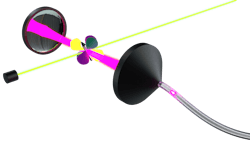While researchers around the globe race to turn quantum computers into reality, it’s no small quest because the basic components of such a computer, quantum bits or qubits, are extremely fragile. In fact, it’s challenging to keep such a fragile system intact and even more difficult to interconnect qubits.
This prompted Benedikt Tissot, a physics Ph.D. student, and Guido Burkard, a professor of condensed-matter theory and quantum information in the physics department at the University of Konstanz, to ask the question: How can a stable exchange of information between qubits be achieved?
Their solution—based purely on theory work—is flying qubits (photons). Tissot and Burkard created a theoretical model of how the information exchange between qubits could work by using photons as a means of transport for quantum information (see video).
The basic premise behind their work is that the information content (electron spin state) of the material qubit can be converted into a flying qubit.
Photons are light quanta and make up the basic building blocks of the electromagnetic radiation field. A special feature of the researchers’ model is that it taps stimulated Raman emissions to convert qubits into photons—and it enables more control over the photons.
Flying qubits
This approach is a “paradigm shift from optimizing the control during the generation of the photon to directly optimizing the temporal shape of the light pulse in the flying qubit,” says Burkard.
Their inspiration “comes from the analogue to the classical internet, to transmit information over longer distances one option is light propagating within an optical fiber,” says Tissot. “If we now think about quantum information and encode our states within quantum states, one option is the quanta of light—a.k.a. photons.”
The principle of information exchange between qubits in a quantum computer works in a similar way. Information must be converted into states that are easy to transmit—and photons are an ideal way to do it.
Fundamentally, the researchers combine the idea of photon shaping, which is already used for single-photon sources, with quantum state transfer. “A simplified picture to contrast this would be that in the first case you would only emit one state ‘|1>’ and in the latter you can emit superpositions of ‘|0>’ and ‘|1>,’” explains Tissot.
Superposition is an essential principle of quantum mechanics and means a quantum system is in multiple states at the same time until it’s measured—think Schrödinger’s cat.
Beyond this, “we account for loss processes that can destroy the quantum state of the matter system we emit from, so that our approach enables optimizing the pulse shape of the photon to balance between detrimental effects of fast varying pulses and these loss processes,” Tissot says.
Theory work
The physicists focused on controlling the direction of information flow, as well as when, how quickly, and where it flows to—with a high level of control.
“The main ingredients are the matter system that needs the appropriate level structure— including the transition emitting the photon, such as defects in semiconductors like the silicon vacancy in diamond, a drive, a laser, and a cavity,” says Tissot. “And the cavity enables emitting the photon in a particular direction of fiber, and the drive can be used to control the pulse shape.”
Their method enables control via resonator-enhanced stimulated Raman emissions—and while it’s an established method in physics, it’s quite unusual to use them to send qubit states directly. But this may make it possible to balance environmental perturbations and unwanted side effects of rapid changes within the temporal shape of the light pulse, which could make information transport more accurate.
“The way we quantify the balance between different detrimental effects to optimize the pulse shape, which by design gives direct access to the pulse shape, can account for different constraints on the resulting pulse shape,” says Tissot. “Furthermore, the approach to generate entanglement between the matter system and the photon uses an ancillary matter state or qubit.”
A cool discovery along the way was “that the combination of accounting for losses with the pulse shaping approach leads to equations that can be straightforwardly reformulated into an optimization problem—maybe not very surprising, but cool,” says Tissot.
And a couple of surprising moments involved “finding these photon shape-dependent results reproducing the (photon shape-independent) photonic memory limit for perfect emitters and slowly varying pulses as well as what we call temporal mode matching,” Tissot adds.
One of the biggest challenges involved in this work was “actually—approximately—solving the dynamics and simplifying the results to be understandable,” says Tissot.
As far as potential future applications, Tissot envisions their method being used for remote entanglement generation or quantum state transfers between modules of a modular quantum architecture.
Next up? “Hopefully someone will implement our approach in the lab,” says Tissot.
FURTHER READING
B. Tissot and G. Burkard, Phys. Rev. Res., 6, 013150 (Feb. 8, 2024); doi:10.1103/physrevresearch.6.013150.

Sally Cole Johnson | Editor in Chief
Sally Cole Johnson, Laser Focus World’s editor in chief, is a science and technology journalist who specializes in physics and semiconductors. She wrote for the American Institute of Physics for more than 15 years, complexity for the Santa Fe Institute, and theoretical physics and neuroscience for the Kavli Foundation.

